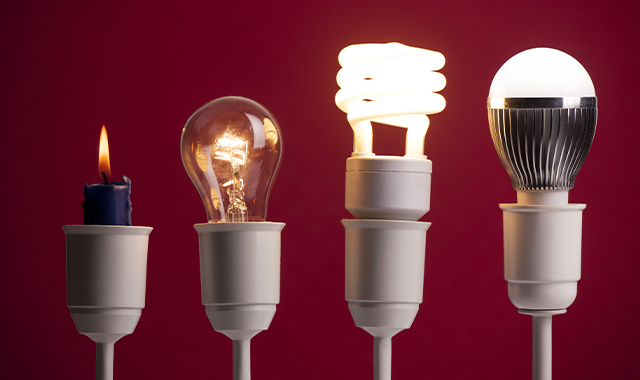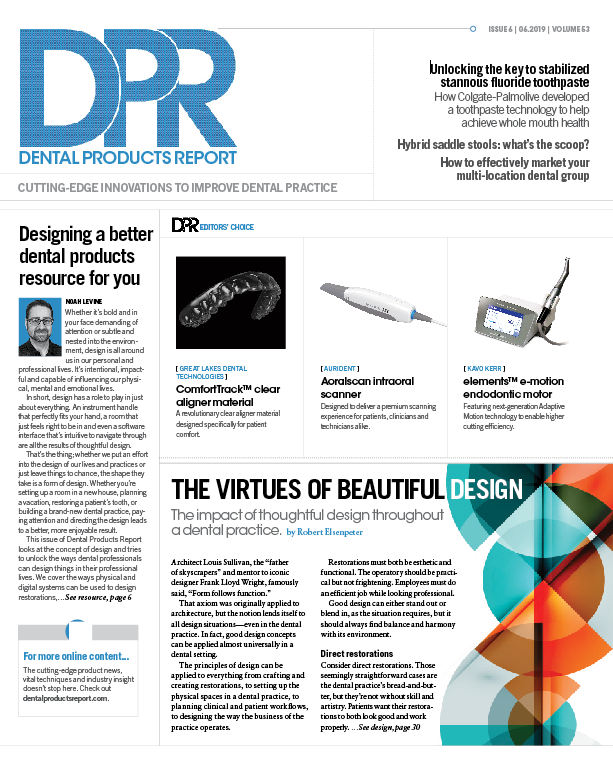Enhanced technologies for faster, easier dental treatments
The basic processes of dentistry are relatively the same as they have been, but the tools at our disposal keep getting better. Check out these enhanced technologies to improve your clinical care.

We live in a world of opposites. Hot and cold, fast and slow, heck, Jimmy Page describes Led Zeppelin’s music as “light and shade.” There are always contrasts and sometimes we need to favor one over the other.
Sometimes in health care slow is the right choice. You can’t do orthodontics overnight; it’s not physically possible. Even if you try and do it faster than normal, you pay the price with shortened roots and a lack of long-term stability.
How about endo? Anyone want a “really fast” root canal, or would you prefer someone take his or her time and use the instruments at their proper speeds? Don’t rush, I’ll wait. Yup, I didn’t think so. If it makes you feel better, I would’ve chosen the same way.
However, at the same time, there’s a balance to everything. The high-speed handpiece supplanted the slow-speed one for most operative dentistry, and that’s a good thing. Can you imagine coming to the office every day and performing crown preps with a slow-speed? For the good of both the doctor and the patient, it’s a good thing we no longer have to do that.
What this whole concept boils down to is the concept of when. When is it a good thing to go faster? What are the benefits and the detriments to speed and power? Like anything in dentistry, and really life in general, it boils down to good decisions based on the available information. The issue is what are the benefits versus the detriments?
With this balance in mind, let’s take a look at some of the technologies that exist that are going to allow you to do more with less effort, less time, less stress, and with greater or equal clinical outcomes.

Preparation
For the last few years now, I’ve been singing the praises of electric handpieces. They’ve become the everyday workhorse in my practice, and there are some definite reasons I’ve chosen to use them.
Air turbines spin up quickly to between 300,000 and 400,000 rpm. As the air from the dental unit slips by the blades on the turbine, it causes it to spin in a similar matter to a water wheel from an 18th-century mill. The turbine and bearings are set up to very tight tolerances to spin that rapidly while keeping the bur turning concentrically.
Trending article: Top innovations announced at CDA PRESENTS Anaheim 2019
However, the weak point in air turbines for dentistry is their torque. Once the bur comes into contact with tooth structure, the friction causes drag on the turbine. This means that in actuality, an air turbine is operating in a range of 150,000-200,000 rpm when prepping. It requires that initial extra force so it doesn’t bog down and stall when in contact with tooth structure.
On the other hand, electrics use a series of gears to create rotation that’s supplied by an electric motor. The electric motor itself is capable of providing enormous amounts of torque without stalling and transfers that torque through the gears. Due to this high level of torque, electric handpieces don’t need to spin up to a higher rpm. They simply don’t bog down when in use.
Because of this consistent torque, preps can be completed in less time and with less stress on both the doctor and the patient.
Continue reading on page two...
Also, when finishing margins, the high torque even at slow rpm is a true game changer. When you can work at low speeds with incredible precision, your margins are easier to read, which makes your restorations have a better fit.
For frightened patients, the ability to work at a slightly slower rpm while accomplishing just as much also can decrease everyone’s stress. Everyone hates the sound of the handpiece, and no matter how quiet it is, the transduction of the vibration throughout the skull is still something that can’t be overcome. By operating at a slightly lower rpm, the operator can decrease the noise of transduction and therefore have a less stressful appointment for the fearful patient.
Finally, because electrics make you more efficient, you spend less time in the clinical posture, which is physically good for you. Being more efficient might just extend your career.
Magnification and headlights
To do better, you need to see better and that starts with clearly seeing the field. More than 80 percent of doctors are now wearing magnification, and that’s great news. What I would recommend is to now consider stepping up your magnification to higher power. Obviously seeing things larger makes you perform better and with greater accuracy. However, there are times where seeing the “big picture” of an entire quadrant is also helpful. How do you manage to increase your magnification and still see the big picture when necessary?
There are a couple of products on the market that allow just that. Both are from Orascoptic. One is the EyeZoom. It’s a single frame that has telescopes with adjustable magnification that can be adjusted for 3.0x. 4.0x and 5.0x. To change the level, you simply rotate the telescopes and they click into place when they reach the next level. They’re great for busy practices where the doctor is providing care and wants to quickly and efficiently change agnification.
The second is the OmniOptic. It’s a single frame with interchangeable telescopes in 2.5x, 3.5x, 4.5x and 5.5x. The telescopes are held in place with strong magnets. You simply pull one set off of the frame and snap another set on. The nice thing about this frame is you can buy only the magnification levels you want and need. If, at a later date, you decide you’d like to increase or decrease your levels, you can just purchase the telescopes you need/want. It’s just that simple.
More from the author: Using technology for better esthetic outcomes
Isolation
As restorative dentistry has evolved, our materials and methods have had to evolve as well. The days of plugging amalgam into holes in teeth submerged in saliva are over. Now we need to concern ourselves with moisture control from a variety of sources and we need to pay particularly close attention to this. Contamination of preps can lead to poor bonding, sensitivity, marginal degradation, recurrent decay and restoration failure.
There are a couple of ways to combat this and also increase your efficiency so you can accomplish more in less time.
The first is through the use of the Isolite. This product is now on its third generation and I’ve been using it in a variety of clinical situations for the last three to four months. The Isolite 3 features a terrific isolation device that’s a bite block, tongue retractor, cheek retractor and vacuum system all in one. Add to that the fact that it also features a multifunction lighting system with white and orange (for curing) and you have an incredible workhorse to keep things in a perfect situation for preparation and bonding.
Continue to page three to read more...
Since I’ve been evaluating the Isolite, I’m routinely prepping for crowns in 15 minutes and that’s with no attempt to increase my speed. Because the patient stays open, everything is retracted and the field is well lit, so you can start prepping and really only stop to change burs.
For bonding procedures, you can prep and then bond by simply switching the light over to the orange wavelength. You can perform an entire quadrant of restorations start to finish with the Isolite in place and only remove it when it’s time to check occlusion. The device makes all restorative procedures faster and easier on all concerned.
Patient response has been around 95 percent positive, and it’s quickly becoming a go-to device in my office.
The other way to have a properly controlled field is to utilize chemistry for hemostasis and sulcular fluid control. Ultradent’s ViscoStat Clear is a great product for this. It provides hemostasis without staining and also drys up crevicular fluid for bonding on areas near or under the gingival margin.
Curing
This is another procedure where you can save time by using the latest, more powerful options. Most LED lights on the market operate with output between 1,200 to 1,500 mW/cm2, but there are some lights that provide much greater intensity.
Ultradent’s Valo and Valo Grand provide intensity of 3,200 mW/cm2, which can cure a standard 2 mm layer of A2 shade composite in three seconds. With a broadband spectrum of 385 to 515 nm, any Valo will cure any existing composite or bonding agent.
Another terrific powerful light is the Dentlight Fusion 5. It has a 4,000 mW/cm2 uniform intensity across the 10 mm curing tip allowing it to also cure most lighter shade composites in three seconds. It has a unique feature that delivers 2,300 mW/cm2 at 10 mm distance away from the tip. This ensures that even if you’re not directly on the composite with the light, you still get a high quality cure.
High-intensity, high-speed curing has been around for more than 10 years now and the concept and process have survived the test of time. You need to heat the pulp 5º C to create inflammation, and if the heat from these devices was causing pulpal necrosis, we would’ve witnessed it by now. Likewise, if it caused extreme stresses such as cuspal deflection or detrimental material shrinkage, we would’ve seen the results of this by this point in time.
While three- to five-second curing isn’t something that adds up to hours saved over a month, it does allow you to work more efficiently and finish cases with less stress and shorter procedural time, which is always a good thing. No one ever wants dentistry to last longer.
Related reading: Break out of your restorative rut
Wrapping up
For me, speed and efficiency decrease my stress level and allow me to spend less time in the clinical posture. I’m not the kind of dentist who wants to do more cases in a day; I simply want to do them better and in less time. When I evaluate a new technology for my practice, my three decision points are:
- Does it provide a better or similar outcome to my current modality?
- Does it allow me to be more efficient?
- Is it financially viable for the business of my practice?
If the answer to those three questions is “yes,” then I explore the possibilities of incorporating it into my practice. The great part about my job as author and lecturer is I then get to tell all of you about what I’ve discovered.
Trust me when I say these powerful tools have been well vetted in my clinic. All the things mentioned here are used with great success in my practice nearly every day and I’m confident you’ll be as impressed with them as I am. See you next month!
